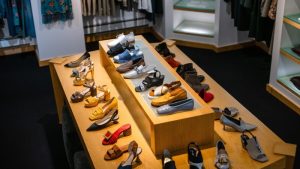Everyone, everywhere is wearing Ami Paris. Why?
Alexandre Mattiussi is excitedly showing me around the offices of his brand Ami Paris, a classical space overlooking the Place des Victoires in the city’s 2nd arrondissement. He points to an enormous bouquet of flowers, sent to him by the actor Issa Rae, who attended his runway show in Paris in June; also a sculpture by Samuel Salcedo depicting three “world leaders” in their underwear with silly hats on. Mattiussi requested the Spanish artist paint his brand’s logo – a capital “A” with a love heart extending from the top – on their fronts, adding to the comedic effect.
The little red motif underscores a very serious and successful business. Certainly, it’s hard to walk through the streets of Paris right now without seeing the embroidered patch on a sweater or shirt. Talk to anyone about Ami and the consensus is that “everyone is wearing it”.
“I love seeing people wearing my clothes, and this is what I see every day,” says Mattiussi, an enthusiastic character dressed in denim and trainers, with diamond studs in each ear and a Cartier Tank on his wrist. “This was my goal. If you go to high schools in France, the brand they want to wear now is Ami, like Lacoste when I was younger. And there are so many copies – if you go to the flea markets in Paris, you have copies of Nike, Ralph Lauren, and now you have Ami next to them.”


In 13 years, Mattiussi has turned his men’s ready-to-wear label into a globally recognised brand, encompassing womenswear, accessories, jewellery and leather goods. Globally, there are more than 60 standalone stores and more than 700 points of sale, and in the year ending March 2023, the brand had revenues of €300mn, up 30 per cent on the previous year and up from €35mn in 2019.
“Ami has captured the spirit of the time with a minimal, relaxed yet functional style that is priced to perfection,” says Mario Ortelli, managing partner of luxury advisors Ortelli & Co. “They started with Europe, and after investment from Sequoia [Capital China, in 2021], they have been able to find good reach in Asia, as well as the regional US. It has been very easy for them to find their way into the wardrobes of men around the world.”

Mattiussi was raised in Normandy, in the village of Gisors, north-west of Paris. After seeing Swan Lake aged four, he decided he wanted to be a ballet dancer, which he practised until he was 14, putting on shows for his parents in the garden. When he moved to Paris after school, though, it was not dance but fashion design that he studied, at Duperré School of Applied Arts. After graduating in 2001, he launched his own label, but it didn’t take off. Instead, he went to work at Dior, for the brand’s 30 Montaigne line, before joining Givenchy as a menswear designer, where he worked for four years. In 2009, he went to Marc Jacobs, splitting his time between New York, Milan and Paris, before settling back in France to launch his own brand again in 2011. He did things differently this time, prioritising investment early on. In 2013, he recruited Nicolas Santi-Weil as CEO, previously a co-founding partner of The Kooples. “I invested a lot of money in a brand that was not even doing €1mn,” says Santi-Weil. “But I had this gut feeling that this guy was smart. He was creative, his head was in the clouds but his feet were grounded.”
Mattiussi’s intention was to design for his friends, resulting in simple, everyday classics, in contrast to the more conceptual offerings from luxury houses. His early menswear collections were filled with normal clothes done well: single- and double-breasted jackets in Prince of Wales checks; zip-up blousons with shearling collars; ribbed and cable-knit sweaters; classic-fit slacks and a lot of jeans. “My approach is very sincere,” he says. “I’m not a niche designer, I’m not an intellectual designer, I’m not a conceptual designer. I want to dress the maximum number of people I can, in a very inclusive way.” It earned Ami the ANDAM prize in 2013, providing Mattiussi with the funds to stage his first runway show in 2014; typical to his inspiration, he imagined a Parisian street with fake snow and lamp posts, which models ambled down, maybe on their way to work or to meet a friend.




While there aren’t many ways to change “classic” wardrobe pieces, Mattiussi finds his creative spice in the details: “I love the idea that menswear has heritage where the rules actually haven’t changed much over the decades. How you excite people is in the fabric, and how the proportions change a little bit from season to season.
“Men are very picky, and so am I,” he continues. “It’s very hard to find a good pair of trousers, with good fabric and good fit, without too many details. But this is what I always do. It’s like going to visit your grandmother on a Sunday, and her serving her best meal, like poulet purée. It’s chicken and mashed potatoes. It has to be easy, it has to be relaxed.”

In 2019, Mattiussi decided to extend this principle to womenswear, to cater to the female shoppers who already made up nearly half of his customer base. Two years before, he had launched the Ami de Coeur line, distinguished by the now-famous heart logo, which has long been Mattiussi’s signature. He had made a white turtleneck sweater, with the motif writ large on the front left side, to close the brand’s AW18 show. “When we started doing this, I was the only one in the room who said: we are going to embroider this on a shirt and it’s going to be a success. In the first season it didn’t take off, but in season two, I tried again. People finally connected the brand with the signature. And it’s love, and it’s an ‘a’” – one of the most popular first initials
The success of the Ami de Coeur logo – usually seen on T-shirts, knitwear and sweatshirts – borders on phenomenon, selling, he says, “millions of garments, hundreds of millions in turnover”. In seasons three and four of Emily in Paris, the Netflix show’s fictional marketing agency orchestrates a campaign in which the brand’s motif is stamped across pink and red hot-air balloons that fly over the French countryside, cementing it within popular culture. “[The show] is not my thing,” says Mattiussi, with a shrug, “but it’s part of the story, and it makes sense for us to be in this kind of playful image of Paris.”

The popularity of the logo has, however, triggered a moment of reflection for Mattiussi and Santi-Weil, who are now dialling back its use. “The knitwear pieces with the logo, and also the hoodies and jerseys, sold so well, the transformation was huge,” says Santi-Weil. “We were happy about it, but it was too much, and that’s why we’ve decided to cool it down.” Mattiussi adds that three years ago, around 50 per cent of the showroom products had logos on them, whereas now it’s around 15 per cent: “I appreciate it, and I’m proud of it, but I don’t want to be only a guy with a logo on his T-shirt.”

Ami has often drawn a kind of snobbery from the industry, which tends to favour more outré designs. One critic, in a 2016 review, said of a runway show: “Nothing to move the fashion horizon forward, but nice.” Mattiussi says today: “I don’t care, because you know what? I’ve tried [to make edgier clothes] and it doesn’t work. And people don’t believe me; when you’re trying too hard, it’s not sincere. (Other critics, meanwhile, are supporters: the FT’s menswear critic, Alexander Fury, recently wrote in this magazine that he swears by Ami trousers.)
Part of what Mattiussi also sees as setting his brand apart is the price point. A pair of men’s woollen trousers sits at around £500, whereas at traditional luxury brands, a similar pair would cost at least two to three times that. “We all share the same factories,” says Mattiussi. “If I wanted to, I could double the price, and of course I could probably get a lot more money, but it’s not fair. And I think [the rise in luxury prices is] becoming a little bit shameful, because the quality is not there all the time.”


“[Ami] offers an attractive bridge between high-priced designer-luxury fashion and everyday wear,” says Fflur Roberts, head of global luxury goods at Euromonitor International. “Recent dramatic price increases at traditional luxury brands and products, coupled with discretionary spending pressures, have priced many middle-income consumers out of the luxury fashion market. Despite this, these consumers still seek trusted fashion brands that align with their values.”
Mattiussi and Santi-Weil plan to increase other areas of the business, including womenswear – they aim to grow the category from less than 20 per cent of sales to between 30 to 40 per cent over the next three to five years. The brand is also broadening its accessories category, including a recently launched eyewear range, as well as through jewellery, shoes and leather goods. Nearly half of the models at the most recent runway show were carrying some sort of squishy, supple bag – a marked increase from previous shows.
“Usually with [fashion] brands, when they grow over €50mn, at least half of the business is accessories,” estimates Santi-Weil. “Over €100mn, it’s at least 60 to 75 per cent. We are only 10 per cent [of accessories], which means we have loyal ready-to-wear fans that are repeat customers.”
Mattiussi is, then, already succeeding in his mission to dress as many people as possible. “Sometimes fashion designers want to be famous,” he says. “Sometimes fashion designers want to revolutionise fashion, or participate in its history. For me, I just want to create clothes that people can wear.”
#wearing #Ami #Paris







